NCERT Solutions For Class 11 Financial Accounting – Recording of Transactions-II
Short Answer Type Questions
Q1. Briefly state how the cash book is both journal and a ledger?
Answer :
Transactions are recorded directly from source documents in the Cash Book, so there is no need to record transactions in the Journal book. Further, on the basis of the cash transactions recorded in the Cash Book, cash and bank balances can be determined, and so there is no need to prepare cash account (which is a part of ledger) separately. Thus, the Cash Book serves the purpose of both Journal as well as ledger.
Q2. What is the purpose of contra entry?
Answer :
Contra entry represents deposits or withdrawals of cash from bank or vice versa. The purpose of contra entry is to indicate the transactions that effect both cash and bank balances. This entry does not affect the financial positions of a business. A contra entry is recorded in both sides of a two column Cash Book and is denoted by ‘C’ in the ledger folio column.
Q3 . What are special purpose books?
Answer :
Business transactions are large in number and difficult to record; so, journal is sub-divided for quick, efficient and accurate recording of the business transactions. Special purpose books like, sales book and purchases book are maintained for those transactions that are routine and repetitive in nature. Recording through these books is economical and enables division of work among accountants.
Q4. What is petty cash book? How it is prepared?
Answer :
Petty Cash Book is used for recording payment of petty expenses, which are of smaller denominations like postage, stationery, conveyance, refreshment, etc. Person who maintains petty cash book is known as petty cashier and these small expenses are termed as petty expenses.
It is prepared by two methods:
1. Ordinary system: In this case, a fixed sum of money is paid to petty cashier for the payment of petty expenses and after spending the whole amount, the account is submitted by the petty cashier to the main cashier.
2. Imprest system: In this case, a fixed sum of the money is given to the petty cashier in the beginning of a period and at the end of the period the amount spent by him is reimbursed, so that he has a fixed amount in the beginning of every new period.
Q5. Explain the meaning of posting of journal entries?
Answer :
Posting is the process of transferring the business transactions from Journal to ledgers.
Every transaction is first recorded in the Journal and subsequently transferred to their respective accounts.
Q6. Define the purpose of maintaining subsidiary journal.
Answer :
The process of accounting starts from identification of financial and non-financial events. Financial events are first recorded in a Journal. A small business has lesser number of transactions and thereby it may be possible to record these transactions through Journal entry. However, on the contrary, as the business grows, there will be voluminous number of transactions and the firm may experience difficulty, thereby it becomes tedious to record through Journal entry. Thus, in order to save time and effort, it is recommended to sub-divide Journal. Sub-division of Journal provides scope for division of work. This leads to the improvement of efficiency and effectiveness and infuses higher degree of accountability to the accountants for the specific subsidiary Journal assigned to them. The purposes of maintaining subsidiary Journal are given below.
1. It saves time and efforts in recording.
2. It enables division of work, leading to an enhancement of efficiency and effectiveness, as particular accountant takes care of particular books.
3. It also makes each accountant more responsible and accountable for the books assigned to them.
4. It records routine and repetitive transactions at one place, which leads to easy accessibility of information and hassle-free communication.
Q7. Write the difference between return inwards and return outwards.
Answer :

Q8. What do you understand by ledger folio?
Answer :
Ledger folio is a page number of an account in ledger that is written in the L.F. column of a journal format. In journal entry, ledger folio number is written corresponding to the name of the account in the L.F. column. It helps in easy locating of the account in the ledger book. It reduces the time in recording and rechecking.
Q9. What is difference between trade discount and cash discount?
Answer :

Q10. Write the process of preparing ledger from a journal.
Answer :
The process of preparing ledger from Journal can be explained with the help of an example. Let us suppose that machinery is purchased from Mr. X, so, the journal entry will be:
Machinery A/c Dr.
To Mr. X Account
In this example, Machinery Account is debited and Mr. X Account is credited. Let us understand the process of preparing ledger from the journal entry.
Account which is debited in the entry:
Step 1: Indentify the account in ledger that is debited, i.e., ‘Machinery Account’.
Step 2: Enter date in the debit side of the ‘Machinery Account’ in the ‘Date’ column.
Step 3: Enter the name of the account as ‘Mr. X Account’ (which is credited in the entry) in the ‘Particulars’ column in the debit side of the Machinery Account.
Step 4: Enter the page number of the journal, where the entry is recorded in the ‘J.F.’ (journal folio) column.
Step 5: Post the corresponding amount in the ‘Amount’ column, which is recorded against ‘Machinery Account’ in the journal entry.
Account which is credited in entry:
Step 1: Indentify the account in ledger that is credited, i.e., ‘Mr. X Account’.
Step 2: Enter date in the credit side of ‘Mr. X Account’ in the ‘Date’ column.
Step 3: Enter the name of the account as ‘Machinery Account’ (which is debited in the entry) in the ‘Particulars’ column in the credit side of the ‘Machinery Account’.
Step 4: Enter the page number of the journal where the entry is recorded in the ‘J.F.’ (journal folio) column.
Step 5: Post the corresponding amount in the ‘Amount’ column, which is recorded against ‘Mr. X Account’ in the journal entry.
Q11. What do you understand by Imprest amount in petty cash book?
Answer :
Imprest amount is an amount of money given by the main cashier to the petty cashier in the beginning of a period. At the end of the period, the amount spent by the petty cashier gets reimbursed in such a manner, that he has the same amount of cash in hand in the beginning of next period. For example, if the main cashier gives an imprest amount of Rs 1,000 to the petty cashier on April 01, 2011 and at the end of the month the petty expenses amount to be Rs 850, which is spent by the petty cashier during the month. In this case, Rs 850 will be reimbursed, so, that on May 01, 2011, the petty cashier will have Rs 1,000 at his disposable to meet petty expenses for the next month.
Long Answer Type Questions
Q1. Explain the need for drawing up the special purpose books.
Answer :
The needs for drawing up the special purpose book are given below.
1. Quick and efficient recording: It is a time consuming process to record all the transactions in a journal. If there are separate books, then recording of transactions can be done more efficiently and timely. So, the need of special purpose book arises.
2. Repetitive nature: In every business, some transactions are similar and repetitive in nature. It will be more convenient to record all similar transactions at one place. For example, all credit sales transactions are recorded in the Sales Book.
3. Economical: It is more economical as recording through the special purpose books saves time and also enhances the efficiency of accountants and clerks.
4. Easy posting: If similar transactions are recorded at one place, posting becomes easier.
5. Complete information at one place: All information related to purchases, sales, cash receipts, payments, etc. are easily and hassle-free available.
Q2. What is cash book? Explain the types of cash book.
Answer :
Cash Book is a book of original entry. It records all transactions related to receipts and payments of cash and deposits in and withdrawals from a bank in a chronological order. In the debit side of the cash book, the cash receipts are recorded in the cash column while all deposits into bank account are recorded in the bank column. On the contrary, in the credit side of the cash book, all cash payments are recorded in the cash column, while all payments through cheques are recorded in the bank column. Usually, it is prepared on monthly basis. Cash book also serves the purpose of principle book (i.e. cash account and bank account).

1. Single Column Cash Book: A single column Cash Book contains one column of amount on both sides, i.e., one in the debit side and other in the credit side. In the single column Cash Book, only cash transactions are recorded. In the debit side of the Cash Book, all cash receipts are recorded, while in the credit side all cash payments are recorded.
2. Double Column Cash Book: A double column Cash Book contains two columns of amount, namely cash column and bank column on both sides. In the cash column of Cash Book, all cash receipts and payments are recorded, according to the rule of Real Accounts. All deposits either in cash or through cheques into the bank account of the business are debited in the bank column and all withdrawals of cash and payments through cheques are credited in the bank column.

3. Triple Column Cash Book: In a triple column Cash Book, there are three columns of amount namely, cash, bank and discount. Discount allowed and discount received are recorded in the discount column. While in the debit side, discount allowed is recorded along with the receipts, either in cash or through cheque; whereas, in the credit side, discount received is recorded, along with the payments made either in cash or by issuing cheques.
4. Petty Cash Book: This book is used for recording payment of petty expenses, which are of smaller denominations like, postage, stationery, conveyance, refreshment, etc. is known as Petty Cash Book.
Q3. What is contra entry? How can you deal this entry while preparing double column cash book?
Answer :
The transaction that is entered in either sides of the double column or three column cash book, affecting both cash and the bank balances concomitantly is called contra entry. These entries result in increase in cash balances and decrease in bank balances or vice versa. In other words, a debit of bank account leads to a credit of cash account and a credit of bank account leads to a debit of cash account. For example, Rs 200 cash deposited into bank. This transaction increases the bank amount on one hand; whereas, on the other hand reduces the cash balance. In this entry, in the debit side of the cash book, ‘Cash’ will be recorded with a balance of Rs 200 in the bank column and in the credit side of the cash book, ‘Bank’ will be recorded with a balance of Rs 200 in the cash column. This entry is a contra entry as it affects both cash and bank balance together. The contra entries are denoted by ‘C’.
Some transactions that lead to contra entry are given below.
1. Opening a bank account
2. Depositing cash into bank
3. Withdrawal from bank
These transactions are recorded in a double column Cash Book as done below.

Q4. What is petty cash book? Write the advantages of petty cash book?
Answer :
Petty Cash Book is used for recording payments of small expenses, which are of smaller denominations such as postage, stationery, conveyance, refreshment, etc. Person who maintains Petty Cash Book is known as petty cashier and these small expenses are termed as petty expenses.
It is prepared by the below given two methods.
1. Ordinary system: Under this system, a certain sum of money is given to the petty cashier for the payment of petty expenses. After spending the whole amount, the accounts are submitted by the petty cashier to the main cashier.
2. Imprest system: Under this system, a fixed sum of money is given to the petty cashier in the beginning of a period to meet the petty expenses to be incurred in that period. At the end of the period, the amount spent by the petty cashier is reimbursed. So, the petty cashier has the same fixed amount of money in the beginning of the next period.
The Performa of Petty Cash Book is given below.

Advantages of Petty Cash Book:
Simple method: Recording of transactions in a petty cash book is easy. In an analytical Petty Cash Book, there exists separate heads for different petty expenses, which makes recording much easier. Recording in a Petty Cash Book does not require formal knowledge of accounting principles and techniques.
Time saving: Recording in Petty Cash Book saves time and efforts of the chief cashier.
Efficient control: At the end of a period,Petty Cash Book is audited by the main cashier, so frauds and errors are less probable.
Convenient handling: Recording in Petty Cash Book is convenient, as entries are to be recorded under separate heads, which makes posting easier and quicker.
Q5. Describe the advantages of sub-dividing the Journal.
Answer :
The advantages of sub division of Journal are given below.
1. Division of work: The lack of sub-division of Journal may lead to chaos and confusions, if large numbers of transactions are to be recorded through Journal entry by more than one accountant. There will be more inflexibility and lack of accountability among the accountants. Sub-division of Journal into Subsidiary Books facilitates division of work. Sub-division enables different accountants to work on different books. This will not only avoid confusions but also enhance the sense of accountability among the accountants.
2. Time saving: The art of recording through subsidiary book is time efficient and more effective as compared to recording through Journal entries.
3. Prompt information: The transactions of similar nature are recorded in a particular Subsidiary Book. This acts as a ready source to access information quicker than through Journal entry.
4. Creates Accountability: Sub-division of Journal entrusts accountants with higher degree of responsibility and accountability for maintaining subsidiary book that are assigned to them.
5. Easy checking: In case discrepancies or errors arise, they can be easily located and rectified, as lesser number of transactions is recorded in a Subsidiary Book than in a Journal.
6. Specialisation: The accountability, responsibility and division of work together enhance the specialisation of each accountant. This is because, routine and repetitive tasks are performed by each accountant.
Q6. What do you understand by balancing of account?
Answer:
Accounts are prepared on weekly, fortnightly, monthly, quarterly or on daily basis. At the end of each period they are balanced. The balancing of the accounts is done in the manner given below.
1. The totals of the debit and credit of an account is calculated, to ascertain which one of them is higher.
2. The higher figure among debit and credit side is written in the grand total cell on both sides of the account, i.e., in debit and in credit side.
3. The next step is to ascertain the difference between the debit total and the credit total. This difference is called ‘Closing Balance’ or ‘Balance carried down’, and is denoted by ‘Balance c/d’.
4. The ‘Balance c/d’ will be shown either in the debit or credit side, whichever totals up into lower amount.
5. If ‘Balance c/d’ is written in the debit side, then the balance is called ‘Credit balance’. On the other hand, if ‘Balance c/d’ is written in the credit side, then the balance is called ‘Debit Balance’.
6. On closing the account, ‘Balance c/d’ is brought forward to the subsequent period, and it is written as ‘Balance b/d’.
Usually, the closing balances of real and personal accounts are forwarded to the next period by this manner. For nominal accounts, Steps 1 to 3 remain same and they are closed by transferring the closing balances either to Trading Account or to Profit and Loss Account.
Numerical Questions
Q1. Enter the following transactions in a simple cash book for December 2005:
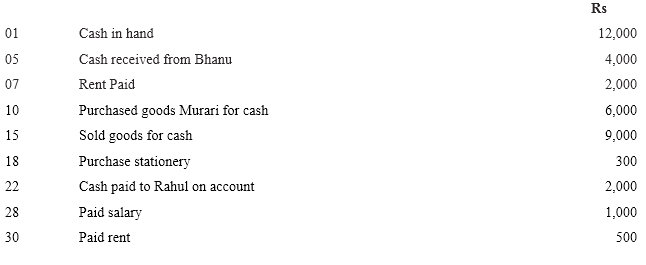
Answer :
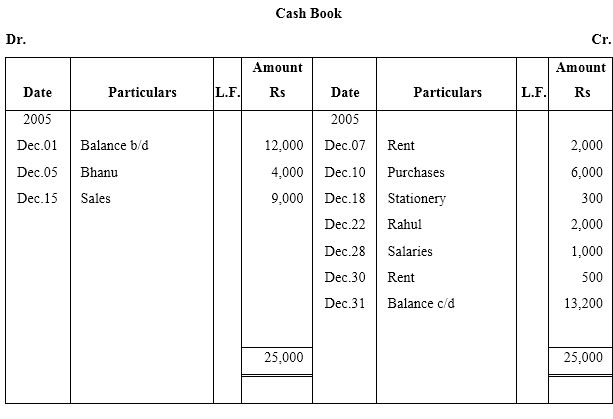
Q2. Record the following transaction in simple cash book for November 2005:
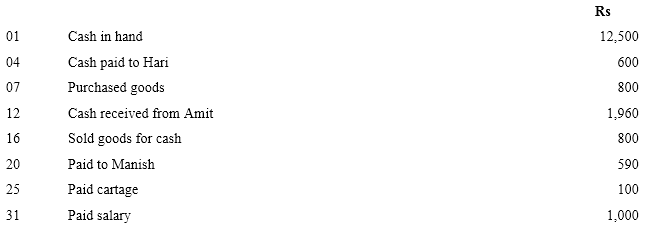
Answer :
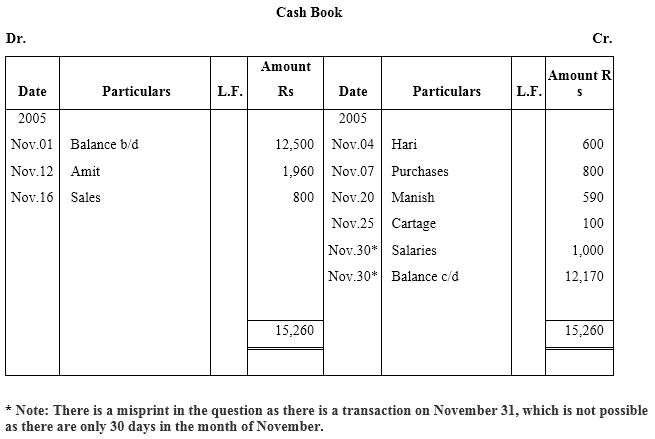
Q3. Enter the following transaction in Simple cash book for December 2005:

Answer :
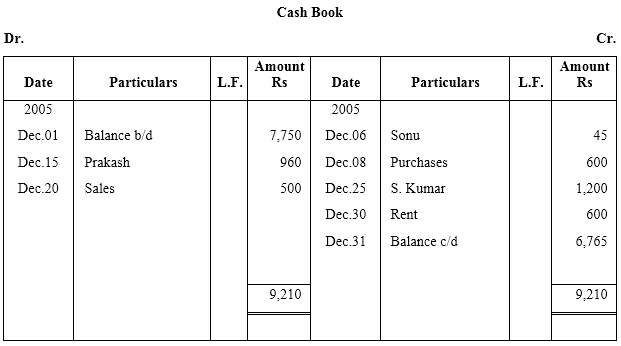
Q4. Record the following transactions in a bank column cash book for December 2005:
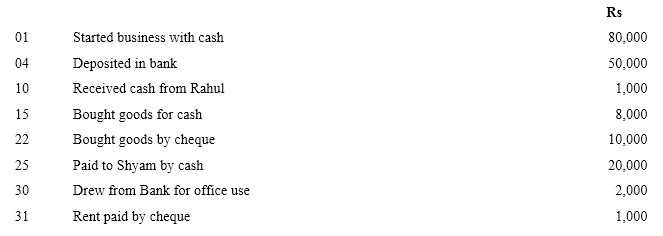
Answer :
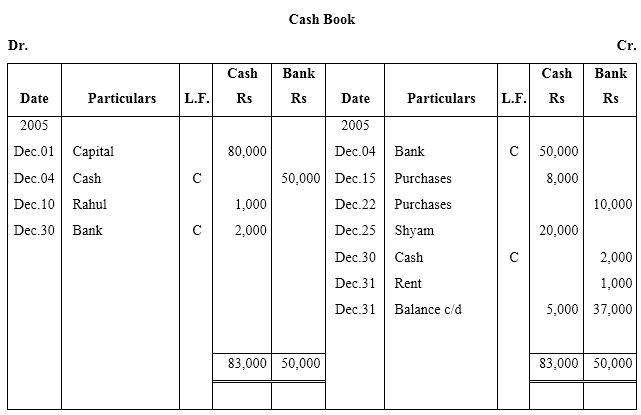
Q5. Prepare a double column cash book with the help of following information for December 2005 :
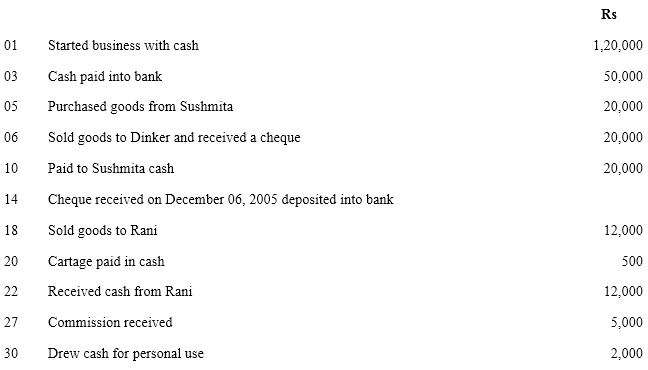
Answer :
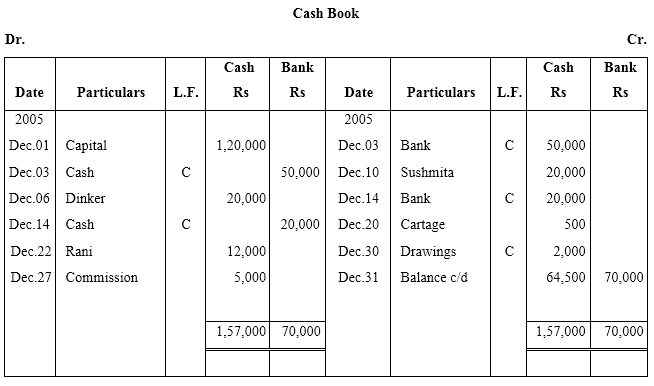
Q6. Enter the following transactions in double column cash book of M/s Ambica Traders for November 2005:
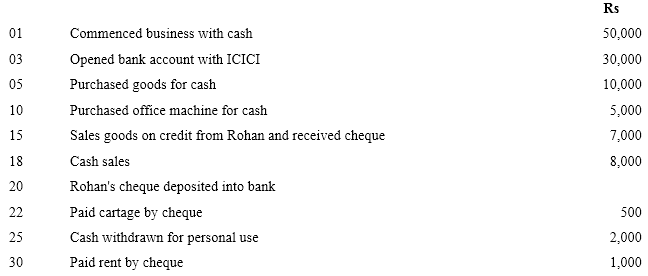
Answer :
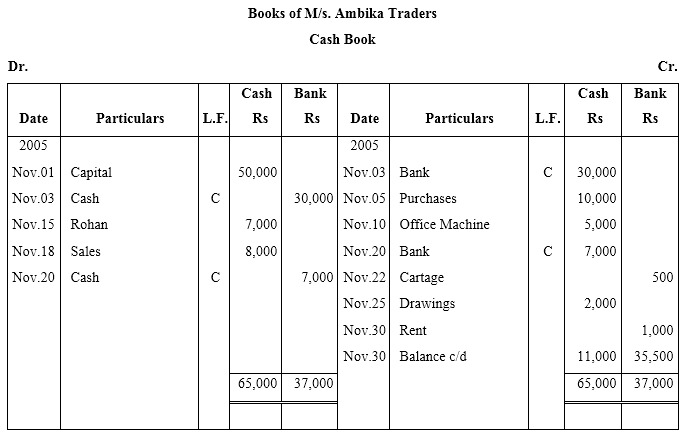
Q7. Prepare double column cash book from the following information for September 2005:
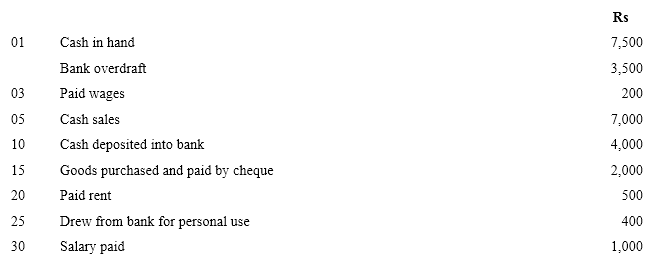
Answer :
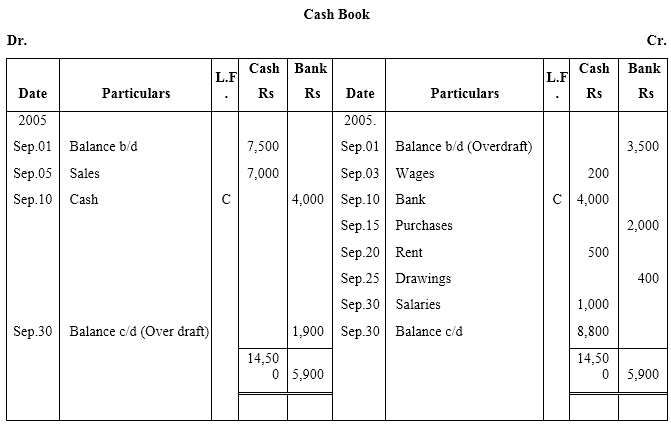
Q8. Enter the following transaction in a double column cash book of M/s Mohit Traders for January 2005:
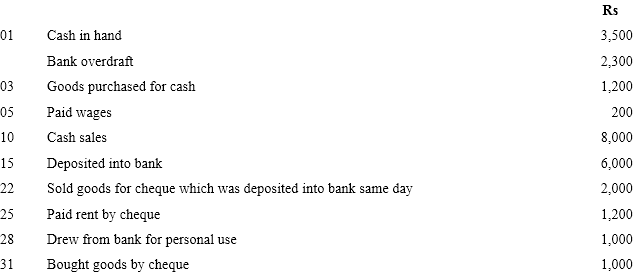
Answer :
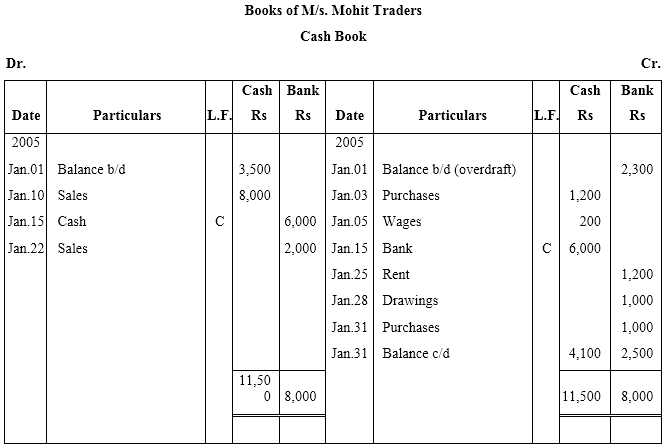
Q9. Prepare double column cash book from the following transactions for the year December 2005:
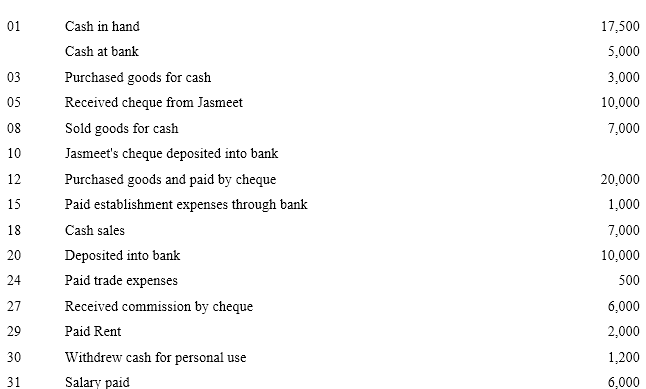
Answer :
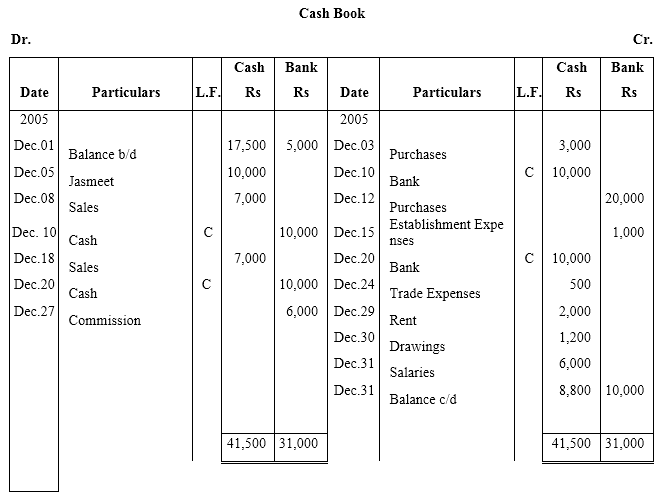
Q10. M/s Ruchi trader started their cash book with the following balances on Dec. 01 2005 : cash in hand Rs 1,354 and balance in bank current account Rs 7,560. He had the following transaction in the month of December, 2005:
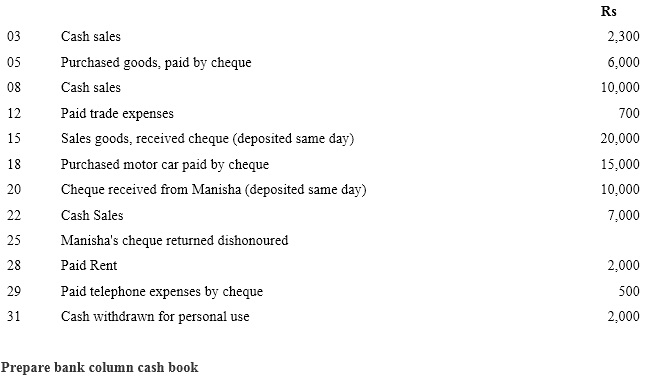
Answer :
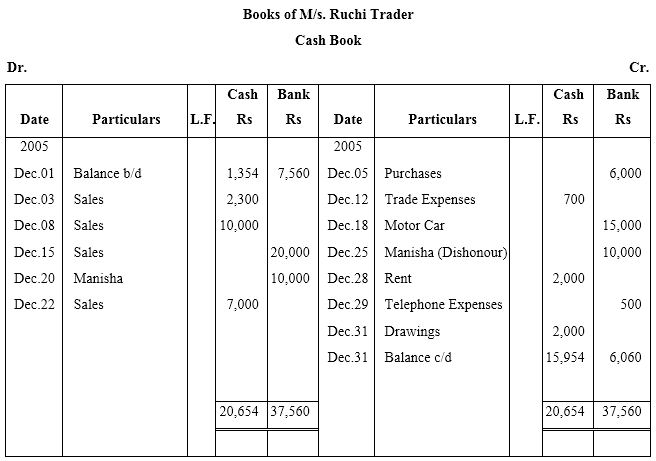
NCERT Solutions Accountancy Business Studies Indian Economic Development Commerce